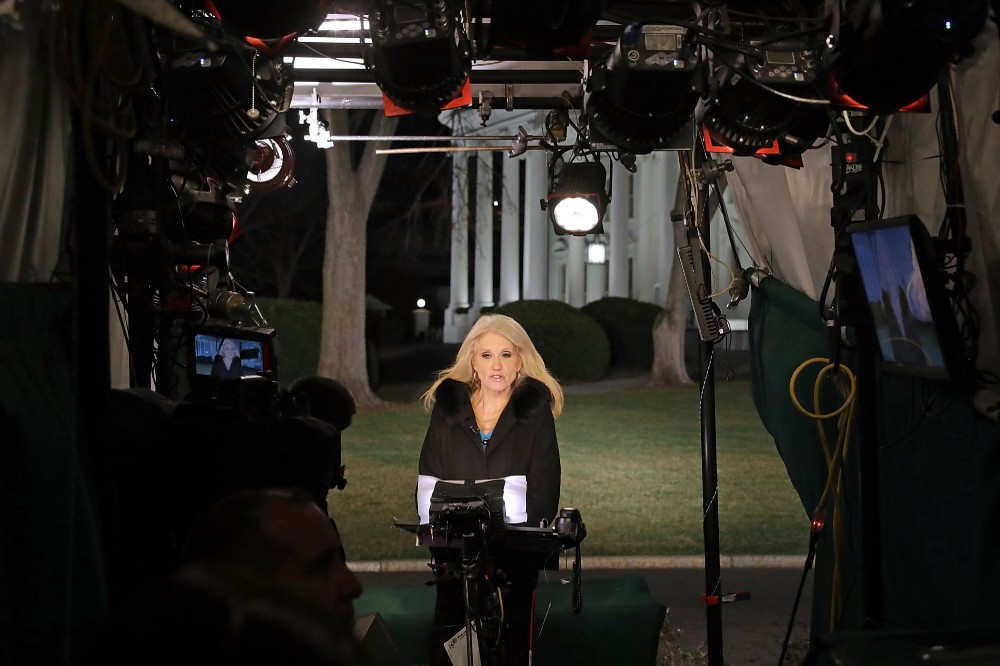
I read Molly Ball’s recent Atlantic article on Kellyanne Conway with some trepidation. I’ve grown tired of Conway’s antics and the political media’s obsession with her, and I don’t think she’s particularly good at whatever job she currently has in the Trump administration. She does herself and the president no favors by going on television and lying and saying things that are inconsistent with the White House line. But, as Ball notes, this may be missing Conway’s real contribution — what she did to create Donald Trump’s presidency.
There’s a long history of policy-minded individuals or interest groups trying to create a space for their message in presidential nominations and finding and grooming a candidate who will carry that message to the White House. Evangelical Christians did this with Ronald Reagan, just as the Democratic Leadership Council did with Bill Clinton. New York Democratic Party boss Robert Farley helped mold Franklin Roosevelt into a presidential candidate in 1932. Businessman Marcus Hanna helped create and manage the campaign of William McKinley in 1896. (West Wing fans will remember Josh Lyman’s role in convincing Representative Matt Santos to run for president and turning him into a credible candidate.)
Ball’s piece portrays Conway in a similar light. Conway was never a terribly prominent political consultant or pundit prior to 2016, but she had staked out important positions on immigration and attitudes toward Muslims that set her apart from the Republican mainstream. She was running polls since the 1990s ostensibly showing that there was significant untapped resentment among white voters toward immigrants.
After Mitt Romney’s 2012 loss, the Republican Party famously produced a post-mortem analysis suggesting, among other things, that the party was alienating those people it needed to win office and that it needed to pass immigration reform to appeal to Latino voters. Much of the party’s leadership promptly embraced this message, and it was widely assumed that the party’s 2016 presidential nominee would be on board with this message and would seek to appeal to Latinos.
A few within the GOP took a different tack, however. Conway, in particular, argued that taking a harder line against illegal immigration would encourage more white voters to turn out, and that a Republican could win office without needing to moderate on immigration or woo Latinos. She had evidence from a poll commissioned by one of her clients, the anti-immigration group NumbersUSA, and she began circulating this poll widely. This was consistent with Sean Trende’s “missing whites” theory of the 2012 electorate. Steve Bannon and others at Breitbart embraced Conway’s findings.
And her campaign remade the 2016 field. As Ball reports:
Republicans began to embrace previously taboo positions. NumbersUSA’s executive director, Roy Beck, watched in amazement as one Republican presidential candidate after another — Scott Walker, Ted Cruz, even Jeb Bush — began parroting his group’s arguments. Trump was the most ardent convert. “Trump started out at, like, a C-minus” on the group’s report card, Beck told me. But he got with the program. “He just kept improving, focusing his message more and more on what was good for the worker.”
Trump was, in some ways, an ideal vessel for such a message. Prior to running for office, he was well known and an enthusiastic public speaker, but his own political stances were poorly defined and highly malleable. Conway helped shape him into a tribune for aggrieved white Republicans who felt that their country and their party had abandoned them in the name of votes and “political correctness.”
Nothing about this was inevitable, of course, and in many ways the experiment got extremely lucky. Had Republican insiders been more organized and concentrated on a different presidential candidate early on, it’s possible Trump and his message wouldn’t have caught fire. There are about a thousand different scenarios in which Clinton would have won the general election, further discrediting the stances backed by Conway and others.
But Conway played no small role in making 2016 turn out the way it did. She advanced a policy vision and groomed a winning presidential candidate to champion it. That’s no small thing.





